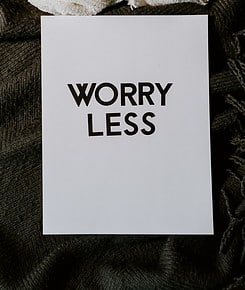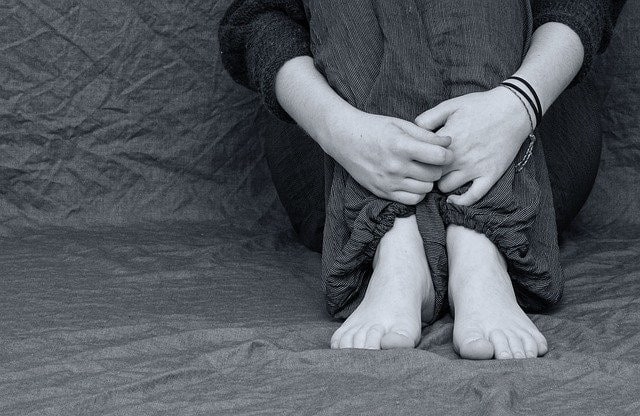How To Worry Less and Enjoy Life More

Experiencing worry in life often leads to considerable stress, disrupting our sleep and concentration. Hours spent dwelling on tasks completed or pending. Here’s a guide to minimize worry and maximize life’s enjoyment.
Women often find themselves excessively preoccupied with every facet of their lives. This heightened concern can introduce challenges in various spheres, impacting work, childcare, and more. Many individuals expend energy on matters beyond their control, leading to heightened stress. Consequently, this can escalate into pronounced anxiety and, in some cases, even depression. Unfortunately, perpetual worry ensnares us, creating uncertainty about how to navigate situations. It’s as though we’ve grown accustomed to this pattern. Fortunately, habits can be altered, heralding the start of a truly transformative life journey. However, before transforming this chronic concern, one must first grasp the essence of worry itself.

Making A Sense of Worry
In the pursuit of diminishing worry and embracing a more joyful existence, it’s essential to grasp the true nature of worrying. A comprehensive comprehension of this concept can significantly impact one’s mental well-being. Such understanding possesses the power to instigate transformative changes in your life, guiding you onto a fresh trajectory.
Worrying can be defined as having persistent fears, anxieties, thoughts, emotions, and repetitive habits. It is also about avoiding situations that could lead to negative conflicts. While not delving into excessive detail, this perspective has evolved into the notion that venturing beyond one’s comfort zone and embracing risks could potentially lead to unfavorable outcomes.
Fear, apprehension, and anxiety all find their home in the brain’s amygdala area. Research indicates that when individuals encounter discomforting scenarios, their amygdala reacts swiftly, resulting in heightened anxiety levels beyond what might have been anticipated.
Those suffering from a mental illness are more likely to have a higher amygdala. This phenomenon stems from persistent apprehensions and worries. As humans, if a negative event occurs in a specific situation, we tend to feel uneasy whenever that situation reoccurs.
Worrying also involves evading anything that might trigger unease related to the unfamiliar. Hence, even in the absence of events, there remains the potential for something to transpire.
Ultimately, persistent fears and concerns hinder us from experiencing a life that holds value. Embracing parenthood, entering into marriage, pursuing a desired career path, leaving a disliked job, or embarking on a long-awaited vacation—these are just a handful of instances.
The Worry-Relieving Formula

Knowing how worry affects one’s life and being able to relieve that worry is a simple formula that leads to living a life full of joy and lowering one’s stress levels.
Living with fewer worries leads to a happier, more prosperous life.
Achieving a life completely devoid of worries is not realistic. Nevertheless, when an individual acknowledges their intrinsic value and untapped capabilities, a profound transformation takes place in every aspect. This endeavor demands substantial commitment and diligence, and with the right mindset, it can indeed be accomplished.
Starting, how many times a day are you worrying about things that have yet to happen? This is referred to as generalized anxiety disorder or GAD for short. It hinges on genetics, individual disposition, life encounters, and a sense of vulnerability. However, through proactive measures, the likelihood of generalized anxiety disorder (GAD) can be diminished. Engaging in physical activity and maintaining a balanced diet is a method to achieve this.
Consequently, individuals similar to myself who have grappled with persistent apprehension can indeed triumph over such anxious unease. Within my personal experience, I employ proactive measures to ease my concerns and fears. This approach serves as a driving force for me to cultivate resilience and diminish the intensity of my stress.
It’s Regarding Positivity
When it comes to anti-worrying, the key is to be positive in everything you do. That being said, I experimented with a few different approaches. I tried rewiring the brain, just taking action anyway, hypnosis, getting out of my comfort zone, exercising (which I still do), writing pros and cons, and writing down everything that I have control over.
I’m just getting started on my journey to stop worrying and start living a joyful life. I realized it was all about changing my mindset and simply saying yes (this can be hard). These behaviors are actions aimed at reducing worry, which we all participate in once our daily routines are familiar, and when we must initiate the process of transformation. This transition typically spans around 28 days to reach its culmination.
Yet, lacking comprehension regarding the nature of worrying and its impact on your daily existence, the prospect of change becomes improbable. Consequently, you persist in your current behaviors while being ensnared by apprehension. Regrettably, to achieve a sense of accomplishment, you become ensnared in an unceasing loop of pessimism, sorrow, anxiousness, and the emergence of even more severe forms of mental disorders. It’s untenable for anyone to endure life under such circumstances.
Ultimately, the key factor is shifting one’s perspective, although this doesn’t imply the eradication of occasional worry or negativity. Rather, it signifies an increased mindfulness of your apprehensions and pessimistic thoughts, followed by proactive measures to transform and cultivate greater happiness.
To learn more about how to change the mindset. I suggest reading my article “The Mindset”.
Powerful Ways to Stop Worrying
To cease worrying and initiate the enjoyment of life, you must opt for a potent set of strategies. Few things are as disheartening as declining opportunities due to the fear of potential mishaps when exploring new experiences. This effectively commandeers your life and hinders the realization of your complete capabilities. Here are some robust methods I’ve acquired during my journey in the realm of alleviating worry, which I’m certain will also prove advantageous to you.
1. Take the Time to Think- Devoting time to introspect on the origins of your worries is essential. Is it stemming from past encounters, a dearth of assistance, a feeling of powerlessness over circumstances, or the challenge of stepping beyond your familiar boundaries? By taking a brief moment to contemplate these aspects, you have the potential to reshape your life.
2. Control- Regarding worrying, one should consider whether they have control over the situation. This is because many people are concerned about things over which they have no control. For example, whether someone likes us.
You can’t always control the outside, but you can control the inside.
3. Take Action- We don’t do things as people because we are afraid of failing, sometimes without even realizing it. Everything else in life would change if you stopped thinking about all the bad things that could happen and just acted. This can be accomplished by acting without thinking when you have an idea. This can significantly aid in the transformation of your life.
4. Hypnosis– Hypnosis can help you do this by removing limiting thoughts and learning to be more positive in life. Try it for at least 28 days to see what occurs. This can make you feel more upbeat and enjoy life. On YouTube, there are numerous hypnosis apps and videos. Consider Calm and Mindvalley.
Some Pages On this website contain sponsored links and advertisements—Affiliate Disclosure.
5. Take a Class- Participating in a course can offer significant advantages in enhancing your understanding of worry and its underlying triggers. These classes generally span from a few hours to several days and involve assignments that prompt introspection. These tasks play a pivotal role in fostering awareness about the necessity for transformative life changes. It is also important to take notes while watching. On Amazon, I recommend the Worry Less, Live More Workbook.
Remember that you’re a human, and perfection is not expected. Once you’ve identified your worries and fears, you can focus on personal growth.
The spotlight is on you now. Take a close look at your life and consider how you could enhance your sense of comfort. Taking action and observing the resulting outcomes is essential in this process.
Feel free to drop any inquiries you might have about managing worries or effectively implementing strategies to reduce them in the comment section. I possess a wealth of expertise in this area and am more than willing to offer my guidance and support.
Kiersti writes on self-love and personal development professionally. Over the past ten or so years, she has studied self-love and personal growth. Visit https://womansdailyneeds.com/ to learn more about what she does, and like her on Facebook at https://facebook.com/womansdailyneeds to keep up with her.



10 Responses
Thank you so much for this great read on how to worry less. Worrying is not good for bodies & the mind. I like to nature walks to clear my mind and think clearly. Having taught about hypnosis will consider this method as well to deal with worries. I am going to share your post with my friends/.
Thanks so much for reading.
Thank you so much for your thoughtful and informative article. It has always been a struggle for me not to worry about certain things, even when logically I know I have no control over them. I really appreciate your analysis of the subject, and your useful and well thought out suggestions about dealing with and overcoming worry. Especially the link to the mindset article and the link to the “Worry Less, Live More” Book. (I almost missed that, you might want to post a picture of the book as well). Anyways thank you so much again and I am so glad I found your wonderful website!
I will be doing a review on that book very soon. I will for sure add a picture though. Thanks for reading.
I find myself worry a lot about finances. Which leads to some severe anxiety attacks. When you are in the process of potentially reliving a perspective catastrophe how does one maintain a different mindset?
Taking action does help distract the mind from the fears of failure but if results of success does not flourish fast enough how does one avoid reverting back to “panic mode”?
When it comes to money, it is one of the major concerns that many people have. When I’m struggling and my mindset is off, I tend to change my thoughts quickly. If you’re curious about the mindset, I recommend reading my article What is the Meaning of the Mindset? I also believe that being able to control one’s thoughts makes a significant difference. Yes, it is very possible. You might also be interested in my article How to Take Control of Your Thoughts.
When it comes to changing your life, you must be consistent. The results will not appear overnight. It takes time and commitment for change to occur. If you want to make a change, it will take between 21 and 90 days for those changes to be recognized. When it comes to panic mode, the best thing to do is to be patient and positive. Yes, this can be difficult, but keep in mind that your journey isn’t over yet. In reality, your journey has only just begun.
Great article.
No one ever came to the end of their life and stated they wished they’d worried more. Indeed, worry is probably the last thing one would want to hang onto, especially during the final moments of life. Yet far too many of us cling to worry like a well-worn blanket, afraid to let go. It’s not exactly comforting,but it is familiar. That doesn’t mean worry adds to quality of life. It’s frankly time to stop worrying so much and learn to enjoy life more.
Thank You!
If one was interested in worrying all the time, it would be very interesting. Worry comes naturally to us, which is why we do it. Thank you for your thoughts and for reading my article.
Your post deals with so many women. I have learned how to deal with many worries over the course of living. However, as time passes it seems there are always more things we can worry about if we want to. With Covid I am sure people’s “worrier” has gone into overdrive.
I have found that often things never happen or are less problematic than what we first believed. Many years I was told by one of my clients, when I had to make adjustments in my business.
He said “Things usually have a way of working out.” And low and behold, I have found out that is true.
When it comes to life, we have a tendency to be concerned about everything. That being said, when we are concerned, it is usually about the most trivial of matters. It is critical to take a moment to sit and relax. When we can relax, we remember that what we were worried about wasn’t so bad in the first place. Thank you for taking the time to read my article.